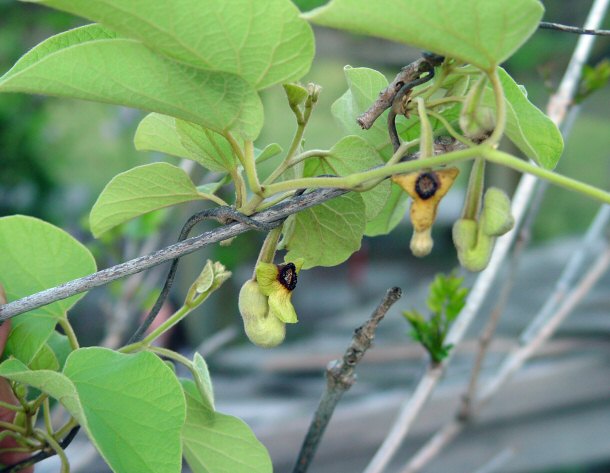Isotrema tomentosa (Sims) H. Huber
Woolly Pipevine

Native
CC = 7
CW = 5
MOC = 46
© DETenaglia
Isotrema tomentosa (Sims) H. HuberWoolly Pipevine | |
 |
Native CC = 7 CW = 5 MOC = 46 |
© DETenaglia |
|
Family - Aristolochiaceae Habit - Perennial liana.
Stems - Twining and climbing on other vegetation, to 25 m, ridged and densely hairy when young, with ridged, brown or gray bark when older.
Leaves - Alternate, petiolate, simple, entire. Petioles to 5 cm. Leaf blades to 20 cm long, ovate to nearly circular, rounded to pointed at the tip, cordate at the base, the main veins palmate, the undersurface densely wooly.
Inflorescence - Flowers solitary or less commonly paired, appearing axillary near the tips of young branches or at the nodes opposite the leaves. Flowers - Zygomorphic with a well-developed calyx tube, this 2.5-6.0 cm long, densely hairy on the outer surface, strongly hooked or S-shaped, expanded at both ends, pale yellowish green, purple to maroon on the inner surface at the mouth. Calyx lobes spreading, triangular to nearly oblong, bright greenish yellow and glabrous on the inner (upper) surface. Stamens 6, the filaments fused with the style into a column. Ovary with 3 locules. Stigmas appearing as a low, irregular, 3-lobed crown at the tip of the stylar column.
Fruits - Capsules 5-8 cm long, barrel-shaped, strongly 6-ribbed. Seeds 8-10 mm long, strongly flattened, triangular in outline, brown, smooth, arranged within the fruit in neatly stacked columns.
Flowering - May - June. Habitat - Bottomland and mesic upland forests, less commonly on gravel bars, sand prairies, disturbed floodplain areas. Origin - Native to U.S. Other info. - This species is found in Missouri mostly south of the Missouri River, where it is reasonably common in bottomlands adjacent to rivers. Its U.S. distribution is a roughly circular region extending from Missouri and Illinois to the Gulf of Mexico. The plant is easy to identify because of its hairy climbing stems, its large cordate leaves which are woolly underneath, and its distinctive flowers. The flowers are bizarre in form, resembling calabash-style pipes. They are often overlooked, being greenish in color, typically hidden by the large leaves, or produced high above the ground. The fruits are more commonly seen and contain numerous flat seeds arranged in neat stacks. Photographs taken along the Current River, Shannon County, MO., 6-5-03, and in Auburn, AL., 4-12-06 (DETenaglia); also near Allenton Access to the Meramec River, St. Louis County, MO, 5-9-2014 (SRTurner). |